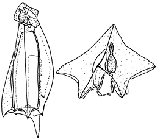Deep-Sea taxon details
Abylidae L. Agassiz, 1862
- Subfamily Abylinae L. Agassiz, 1862
- Genus Abyla Quoy & Gaimard, 1827
- Genus Ceratocymba Chun, 1888
- Subfamily Abylopsinae Totton, 1954
- Genus Abylopsis Chun, 1888
- Genus Enneagonum Quoy & Gaimard, 1827
marine, brackish, fresh, terrestrial
recent only
Agassiz, L. (1862). Contributions to the natural history of the United States of America. <em>Little Brown, Boston.</em> 4: 1-380, pls 1-19., available online at https://www.biodiversitylibrary.org/page/16068829
page(s): 372 [details]
page(s): 372 [details]
Schuchert, P. (2024). World Hydrozoa Database. Abylidae L. Agassiz, 1862. Accessed through: Glover, A.G.; Higgs, N.; Horton, T. (2024) World Register of Deep-Sea species (WoRDSS) at: https://www.marinespecies.org/deepsea/aphia.php?p=taxdetails&id=135336 on 2024-04-19
Glover, A.G.; Higgs, N.; Horton, T. (2024). World Register of Deep-Sea species (WoRDSS). Abylidae L. Agassiz, 1862. Accessed at: https://marinespecies.org/deepsea/aphia.php?p=taxdetails&id=135336 on 2024-04-19
Date
action
by
original description
Agassiz, L. (1862). Contributions to the natural history of the United States of America. <em>Little Brown, Boston.</em> 4: 1-380, pls 1-19., available online at https://www.biodiversitylibrary.org/page/16068829
page(s): 372 [details]
context source (Hexacorallia) Fautin, Daphne G. (2013). Hexacorallians of the World. (look up in IMIS) [details]
additional source Totton, A. K. 1965. A Synopsis of the Siphonophora. London, British Museum (Natural History). Pp. 230. [details]
redescription Sears, M. (1953). Notes on siphonophores. 2. A revision of the Abylinae. <em>Bulletin of the Museum of comparative Zoölogy of Harvard College.</em> 109: 1-119., available online at https://www.biodiversitylibrary.org/page/3886008 [details]
page(s): 372 [details]
context source (Hexacorallia) Fautin, Daphne G. (2013). Hexacorallians of the World. (look up in IMIS) [details]
additional source Totton, A. K. 1965. A Synopsis of the Siphonophora. London, British Museum (Natural History). Pp. 230. [details]
redescription Sears, M. (1953). Notes on siphonophores. 2. A revision of the Abylinae. <em>Bulletin of the Museum of comparative Zoölogy of Harvard College.</em> 109: 1-119., available online at https://www.biodiversitylibrary.org/page/3886008 [details]
 Present
Present  Inaccurate
Inaccurate  Introduced: alien
Introduced: alien  Containing type locality
Containing type locality
From editor or global species database
Diagnosis Calycophorae which develop a temporary larval bract before the larval nectophore, the latter is retained in the polygastric stage as the anterior nectophore. All but one species develop a second (definitive) nectophore, the posterior one, which is usually considerably larger than the anterior one and does not possess a somatocyst. The nectophores are ridged and angular, the posterior one usually bearing serrated ridges and teeth. The hydroecium of the anterior nectophore is an enclosed tube opening basally. [details]
| Language | Name | |
|---|---|---|
| Japanese | ハコクラゲ科 | [details] |








